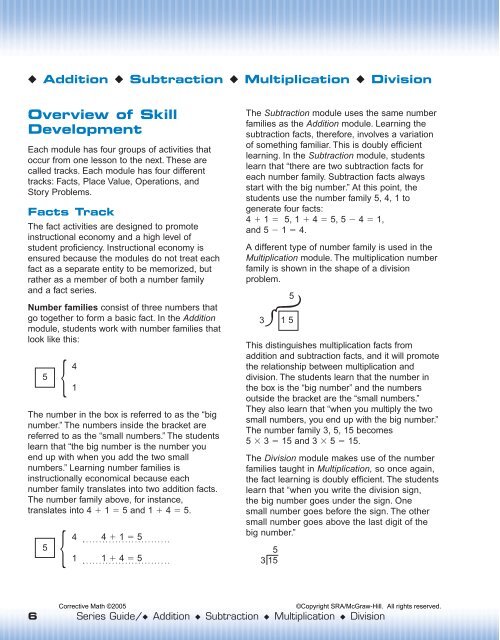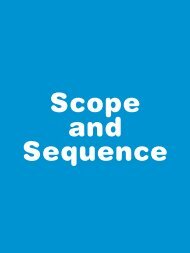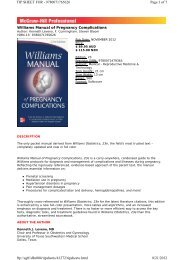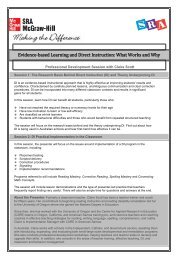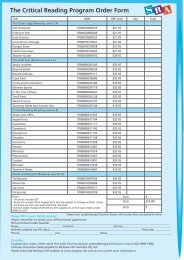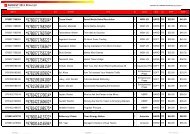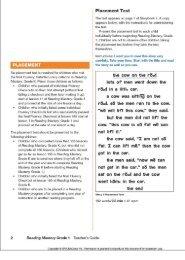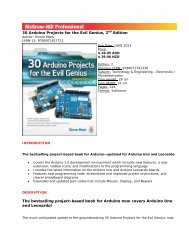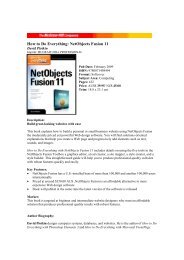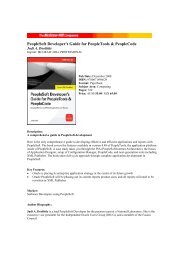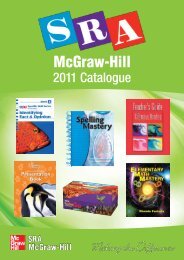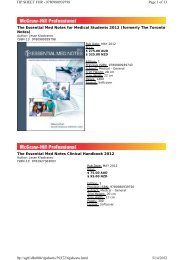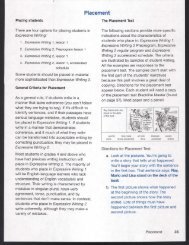Addition, Subtraction, Multiplication, Division - McGraw-Hill Australia
Addition, Subtraction, Multiplication, Division - McGraw-Hill Australia
Addition, Subtraction, Multiplication, Division - McGraw-Hill Australia
Create successful ePaper yourself
Turn your PDF publications into a flip-book with our unique Google optimized e-Paper software.
◆ <strong>Addition</strong> ◆ <strong>Subtraction</strong> ◆ <strong>Multiplication</strong> ◆ <strong>Division</strong>Overview of SkillDevelopmentEach module has four groups of activities thatoccur from one lesson to the next. These arecalled tracks. Each module has four differenttracks: Facts, Place Value, Operations, andStory Problems.Facts TrackThe fact activities are designed to promoteinstructional economy and a high level ofstudent proficiency. Instructional economy isensured because the modules do not treat eachfact as a separate entity to be memorized, butrather as a member of both a number familyand a fact series.Number families consist of three numbers thatgo together to form a basic fact. In the <strong>Addition</strong>module, students work with number families thatlook like this:541The number in the box is referred to as the “bignumber.” The numbers inside the bracket arereferred to as the “small numbers.” The studentslearn that “the big number is the number youend up with when you add the two smallnumbers.” Learning number families isinstructionally economical because eachnumber family translates into two addition facts.The number family above, for instance,translates into 4 1 5 and 1 4 5.5{{414 1 51 4 5The <strong>Subtraction</strong> module uses the same numberfamilies as the <strong>Addition</strong> module. Learning thesubtraction facts, therefore, involves a variationof something familiar. This is doubly efficientlearning. In the <strong>Subtraction</strong> module, studentslearn that “there are two subtraction facts foreach number family. <strong>Subtraction</strong> facts alwaysstart with the big number.” At this point, thestudents use the number family 5, 4, 1 togenerate four facts:4 1 5, 1 4 5, 5 4 1,and 5 1 4.A different type of number family is used in the<strong>Multiplication</strong> module. The multiplication numberfamily is shown in the shape of a divisionproblem.3|515This distinguishes multiplication facts fromaddition and subtraction facts, and it will promotethe relationship between multiplication anddivision. The students learn that the number inthe box is the “big number” and the numbersoutside the bracket are the “small numbers.”They also learn that “when you multiply the twosmall numbers, you end up with the big number.”The number family 3, 5, 15 becomes5 3 15 and 3 5 15.The <strong>Division</strong> module makes use of the numberfamilies taught in <strong>Multiplication</strong>, so once again,the fact learning is doubly efficient. The studentslearn that “when you write the division sign,the big number goes under the sign. Onesmall number goes before the sign. The othersmall number goes above the last digit of thebig number.”5315Corrective Math ©2005©Copyright SRA/<strong>McGraw</strong>-<strong>Hill</strong>. All rights reserved.6 Series Guide/◆ <strong>Addition</strong> ◆ <strong>Subtraction</strong> ◆ <strong>Multiplication</strong> ◆ <strong>Division</strong>
<strong>Division</strong>The division operation is first introduced forsingle-digit divisor problems. Students underlinethe part of the dividend that is at least as big asthe divisor. Next, they work the underlinedproblem and find the remainder for that part.Then, they bring down the next digit and workthe new problem in the same way. Theycontinue in this manner until they have written anumber above the last digit of the dividend. Thissignals that the problem is finished.The single-digit divisor strategy is first shownwith problems that have 1- and 2-digit answers.Early problems do not have answers with zeros.Later problems present 3-digit answers,answers with zero in the middle, and answerswith zero as the final digit. Special exercisesfocus on these troublesome types of divisionproblems.For 2-digit divisors, the procedure is the sameas that for single-digit divisors, except thestudents round off the divisor and theunderlined part of the problem to the nearesttens number. For example, if the problem is63 483, students write the rounded-off problemas 6 48 . The rounding-off sometimes leads totrial answers that are either too large or toosmall. Students are taught to determine whetherthe remainder is too large, and if it is, to makethe answer larger. If the remainder is too small(a negative number), students make the answersmaller. By the end of the module, students cansolve problems of these types:44 5900 24 216534 3618 75 3052Problem-Solving RoutinesThe most important feature of the operationsportions of these modules is that the problemsolvingroutines are introduced only after youhave taught all preskills necessary for errorlessstudent performance. For the students, theroutines are simply procedural chains of familiardiscriminations and responses, and success isensured.The care with which each necessary preskill isintroduced is well demonstrated by theoperations activities in the <strong>Subtraction</strong> module.Before the students learn the routine forsubtracting with borrowing in one column, theymaster these preskills:• Rewriting numbers by borrowing. Given anumber with one digit slashed, the studentslearn to borrow from the slashed digit. Thestudents write the borrowed amount in frontof the digit immediately to the right of theslashed digit.Given 35722Students write 3 1 572• Subtracting multidigit numbers withoutborrowing. Given a multidigit subtractionproblem, the students learn to subtract thebottom digit from the top digit in eachcolumn, starting with the ones column.GivenStudents begin with the ones column andwrite 841 410431• Minusing zero when zero is not written.Given a subtraction problem in whichthe minuend has more digits than thesubtrahend, the students learn that theabsence of a digit in the subtrahend meansthey must subtract zero.Given841 410348 7Students write 348 7341Corrective Math ©2005©Copyright SRA/<strong>McGraw</strong>-<strong>Hill</strong>. All rights reserved.Series Guide/◆ <strong>Addition</strong> ◆ <strong>Subtraction</strong> ◆ <strong>Multiplication</strong> ◆ <strong>Division</strong> 9
• Determining when and where to borrow.Given a partial subtraction problem, thestudents learn that “if you’re minusing morethan you start with, you have to borrow.” Thestudents use a slash to indicate the positionof the digit they would borrow from.GivenStudents write• Subtracting when borrowing has beendone. Given a problem in which borrowinghas been done for the students, thestudents learn to subtract accurately.GivenStudents write23 1 4 1823 1 4 18• Practice borrowing. Given a problemrequiring borrowing, students learn torewrite the digits in the minuend.GivenStudents write2 72 71652 3645 1 2 365 35 3Only after the students have mastered all sixpreskills are they introduced to the borrowingroutine.1. The students read the problem in the onescolumn.2. The students determine whether they haveto borrow.3. If borrowing is necessary, theyA. Determine which number to borrow from.B. Slash that number, and write the numberthat is left.C. Write a 1 in front of the number to theright of the number borrowed from.D. Reread the problem in the ones column,and subtract.The same care is taken later in the <strong>Subtraction</strong>module when teaching the preskills required forborrowing from consecutive columns andborrowing from zero. The same care is alsotaken in <strong>Addition</strong>, <strong>Multiplication</strong>, and <strong>Division</strong>modules. In every case, all necessary preskillsare taught before problem-solving routines areintroduced.Story Problems TrackOne of the major strengths of the CorrectiveMathematics program is that CorrectiveMathematics teaches a precise strategy fordetermining which mathematics operation isrequired by a given story problem—a featurenot typically shared by other mathematicsprograms.Story problems are introduced in the <strong>Addition</strong>module through three major exercises:working with pictures, working with sentencesin columns, and working with sentences inparagraphs.<strong>Addition</strong> story problems include distracters,numbers that appear but are not used incomputing the answer. Two types of distractersare presented: distracters that involve the wrongclass of object and those that involve the wrongverb. Here is an example of a story problemwith a distracter that is from the “wrong class ofobjects” (rosebushes).There are 528 apple trees. There are4108 cherry trees. There are 180rosebushes. There are 600 oak trees.How many trees are there?Corrective Math ©2005©Copyright SRA/<strong>McGraw</strong>-<strong>Hill</strong>. All rights reserved.10 Series Guide/◆ <strong>Addition</strong> ◆ <strong>Subtraction</strong> ◆ <strong>Multiplication</strong> ◆ <strong>Division</strong>
Here is an example of a story problem with twoverbs that distract, that are irrelevant to theoperation (built, rode).261 teachers went swimming. 493students built forts. 97 parents wentswimming. 135 students rode bikes. 2580children went swimming. How manypeople went swimming?Although students learn in the <strong>Subtraction</strong>module that certain verbs generally indicatewhether to add (find, get, buy) or subtract (lose,give away, break), they quickly learn that theycannot rely solely on the verb to determine theappropriate operation. For example, thefollowing problem calls for addition, even thoughgive away would seemingly call for subtraction.Bill gives away 4 toys. John gives away 2toys. How many toys did the boys giveaway?Because using the verb to determine whetheraddition or subtraction is called for is not aviable strategy for many story problems, the<strong>Subtraction</strong> module quickly teaches thisdiscrimination strategy: If the problem gives thebig number, it’s a subtraction problem; if theproblem does not give the big number, it’s anaddition problem. (The “big number” is theminuend in a subtraction problem and the sumin an addition problem.) The strategy isillustrated by the following problems.Mr. Yamada had 36 books. Last weekhe bought more books at the usedbookstore. Now he has 58 books. Howmany books did he buy last week?In this problem, the big number, 58, is given.Therefore, the problem is a subtraction problemand translates into58 36In the second problem, the big number (howmany windows in all) is not given.An office building has 2365 cleanwindows. The window washers haveto wash 90 dirty windows. How manywindows in all does the building have?Therefore, the problem is an addition problemand translates into2365 90In the <strong>Multiplication</strong> module, the students aretaught that “if you use the same number againand again, you multiply.”There are 9 alarm clocks, 9 wall clocks,and 9 grandfather clocks in the shop. Howmany clocks are there in all?In this problem, the same number is used againand again. The problem is a multiplicationproblem and translates into9 3 If the same number is not used again andagain, the problem is not a multiplicationproblem. It must be an addition or a subtractionproblem.There are 5 green flowers, 4 red flowers,and 2 blue flowers in bloom. How manyflowers are there in all?Because the big number is not given, theproblem is an addition problem and translatesinto54 2Students also learn that the words each andevery signal that the same number is beingused again and again. This problem, therefore,is a multiplication problem.Corrective Math ©2005©Copyright SRA/<strong>McGraw</strong>-<strong>Hill</strong>. All rights reserved.Series Guide/◆ <strong>Addition</strong> ◆ <strong>Subtraction</strong> ◆ <strong>Multiplication</strong> ◆ <strong>Division</strong> 11
There are 9 books on each shelf. Thereare 3 shelves. How many books are therein all?In the <strong>Division</strong> module, the discriminationstrategy is expanded. The students learn toapply two tests to story problems.1. If the same number is used again and again,the problem is either a multiplication problemor a division problem. If the same number isnot used again and again, it’s an addition ora subtraction problem.2. In problems involving multiplication ordivision, the problem requires division if thebig number is given and multiplication ifthe big number is not given. In problemsinvolving addition or subtraction, the problemrequires subtraction if the big number isgiven and addition if the big number isnot given.In the problem below, the same number is usedagain and again, so the problem is eithermultiplication or division.Every day Mattie read 3 books. Mattieread 18 books in all. How many days didMattie read books?The big number is given, so the problem is adivision problem that translates to3 18The strategy ensures that the students willattend closely to all the words in a storyproblem, even in the <strong>Addition</strong> module where nodiscrimination between operations is possible.An additional strength of the Story Problemstrack of the modules is that the students aretaught to apply their discrimination strategies toa wide variety of problem types, such as in the<strong>Subtraction</strong> module.• Simple Action. A “subtraction verb,” broken,calls for subtraction.Ann found 206 pencils. 78 of the pencilswere broken. How many of the pencilswere not broken?• Complex Action. An “addition verb,” built,calls for subtraction.There were 143 cabins at the lake. Thisyear more cabins were built. Now thereare 160 cabins. How many more cabinswere built at the lake?• Classification. Numbers for the smallerclasses are added.The shop had 86 apples and 90 oranges.How many pieces of fruit did the shophave?• Comparison. Younger age is subtractedfrom older age.Ms. Savas is 42 years old. Ms. Hark is 70years old. How many years older is Ms.Hark?Furthermore, the specific preskills for eachproblem type are carefully taught. For instance,before being presented with addition andsubtraction classification problems, the studentsare taught the class name for the big number. Ina problem involving hammers, tools, and saws,students are taught that tool is the name for thebig number because hammers are tools andsaws are tools.Place-Value TrackIn the <strong>Addition</strong>, <strong>Subtraction</strong>, and <strong>Multiplication</strong>modules, students learn about place value. Theyare taught to read numbers as long as fivedigits and to write these numbers, puttingcommas in appropriate places. They learn todeal with numbers that include one or morezeros. They receive practice in identifying thedigits in a number as belonging to the ones,tens, hundreds, or thousands columns. Thestudents then learn to write dictated numbers incolumns with the digits properly aligned.4263212634Corrective Math ©2005©Copyright SRA/<strong>McGraw</strong>-<strong>Hill</strong>. All rights reserved.12 Series Guide/◆ <strong>Addition</strong> ◆ <strong>Subtraction</strong> ◆ <strong>Multiplication</strong> ◆ <strong>Division</strong>
Scope and Sequence Chart<strong>Addition</strong>1 5 10 15 20 25 30 35 40 45 50 55 60 65FactsDetermine the sum of any two 1-digit numbers.Write two facts as any two given 1-digit numbers.Say a series of consecutively ordered facts. For example,7 1 8, 7 2 9, 7 3 10.Determine the sum of a 2-digit number plus a 1-digitnumber. The digit in the tens column of the sum is the sameas the digit in the tens column of the 2-digit addend. Forexample, 14 5 19.Determine the sum of a 2-digit number plus a 1-digitnumber. The digit in the tens column of the sum is one tengreater than the digit in the tens column of the 2-digitaddend. For example, 14 8 22.Place ValueSay the number for a 3-digit numeral.Write the numeral for any 2- or 3-digit number.Say the number for a 4-digit numeral.Say the number of tens in a 2-digit numeral.Write the numeral for any 4-digit number.OperationsDetermine the sum of two 2- or 3-digit numbers. Noregrouping. Vertical format.Determine the sum of two 2- or 3-digit numbers. Noregrouping. Horizontal format.Determine the sum of three or four single-digit numbers.With and without regrouping.Determine the sum of three or four 2-digit numbers. Noregrouping.Determine the sum of three or four 1- or 2-digit numbers.The sum of the ones column is greater than 9.Determine the sum of three or four 1-, 2-, or 3-digitnumbers. The sum of the ones column as well as the sum ofthe tens column is greater than 9. Regrouping required.Determine the sum of three or four 1-, 2-, 3-, or 4-digitnumbers. The sums of the ones, tens, and/or hundredscolumns are between 10 and 20. Regrouping required.Determine the sum of three or four 2-, 3-, or 4-digitnumbers. The sums of the ones, tens, and/or hundredscolumns are between 10 and 35. Regrouping required.Story ProblemsDetermine the sum in a story problem with extraneousinformation. (Picture problems.)Determine the sum in a story problem with extraneousinformation. (Sentences in columns.)Determine the sum in a story problem with extraneousinformation. (Paragraph form.)Key: TeachReviewCorrective Math ©2005©Copyright SRA/<strong>McGraw</strong>-<strong>Hill</strong>. All rights reserved.Series Guide/◆ <strong>Addition</strong> ◆ <strong>Subtraction</strong> ◆ <strong>Multiplication</strong> ◆ <strong>Division</strong> 13
Scope and Sequence Chart<strong>Subtraction</strong>1 5 10 15 20 25 30 35 40 45 50 55 60 65FactsDetermine the 1-digit difference between a 2-digit number(less than 19) and a 1-digit number.Write two subtraction facts for any given 1- or 2-digitminuend and a 1-digit subtrahend.Say a series of consecutively ordered facts. For example,10 1 9; 10 2 8; 10 3 7.Place ValueSay the number for a 3-digit numeralSay the number for a 4-digit numeral.Say the number in each column of a 3- or 4-digit numeral.Write the numeral for any 3- or 4-digit number.OperationsDetermine the difference between two numbers less than10,000. No regrouping required.Determine the difference between two numbers less than10,000. Regrouping required for one column.Determine the difference between two numbers less than10,000. Regrouping required for two nonconsecutivecolumns.Determine the difference between two numbers less than10,000. Regrouping required. The column from which astudent must regroup has zero in the minuend.Determine the difference between two numbers less than10,000. Regrouping required for two consecutive columns.Determine the difference between two numbers less than10,000. Regrouping required. Horizontal format.Determine the difference between two numbers less than10,000. Regrouping required. The column from which thestudent must regroup and the column next to it have zerosin the minuend.Story ProblemsDetermine the difference or sum in a story problem in whichthe verbs signify the operation that is required.Determine the difference or sum in a story problem thatincludes higher- and lower-order classes. For example:There were 27 girls on the school bus. There were 40students in all on the bus. How many boys were on the bus?Determine the difference or sum in a story problem in whichthe verb usually signifies addition.Determine the difference or sum in a story problem that hasthe word not. For example: 96 children went to a play. 46 ofthe children enjoyed the play. The rest did not. How manychildren did not enjoy the play?Determine the difference or sum in a story problem thatincludes comparisons.Key: TeachReviewCorrective Math ©2005©Copyright SRA/<strong>McGraw</strong>-<strong>Hill</strong>. All rights reserved.14 Series Guide/◆ <strong>Addition</strong> ◆ <strong>Subtraction</strong> ◆ <strong>Multiplication</strong> ◆ <strong>Division</strong>
Scope and Sequence Chart<strong>Multiplication</strong>1 5 10 15 20 25 30 35 40 45 50 55 60 65FactsDetermine the product of two 1-digit numbers.Write two multiplication facts for any two 1-digit numbers.Say a series of consecutively ordered facts. For example,5 5 25; 5 6 30.Determine the sum of a 2-digit number and a 1-digitnumber.Determine the product of two 1-digit numbers, one of whichis zero.Place ValueSay the number for a 3-digit numeral.Say the number in each column of a 2-digit number.Say the number for a 4-digit numeral.Say the number for a 5-digit numeral.OperationsDetermine the product of a 2- or 3-digit number and a1-digit number. No regrouping required.Determine the product of a 2-digit number and a 1-digitnumber. Regrouping required.Determine the product of a 3-digit number and a 1-digitnumber. Regrouping required for two columns.Determine the product of two 2-digit numbers.Determine the product of a 2-digit number and a 3-digitnumber.Determine the product of a 2-digit number and a 1-digitnumber. The multiplier has a zero in the ones column.Story ProblemsDetermine the product or sum in a story problem with two1-digit numbers.Determine the product or sum in a story problem with a2- or 3-digit number and a 1-digit number.Determine the product, sum, or difference in a storyproblem with a 2- or 3-digit number and a 1-digit number.Determine the product, sum, or difference in a storyproblem with a 2-digit number and a 2- or 3-digit number.Key: TeachReviewCorrective Math ©2005©Copyright SRA/<strong>McGraw</strong>-<strong>Hill</strong>. All rights reserved.Series Guide/◆ <strong>Addition</strong> ◆ <strong>Subtraction</strong> ◆ <strong>Multiplication</strong> ◆ <strong>Division</strong> 15
Scope and Sequence Chart<strong>Division</strong>1 5 10 15 20 25 30 35 40 45 50 55 60 65FactsWrite two division facts for any given 1- or 2-digit dividendand a 1-digit divisor.Determine the 1-digit quotient of a 1- or 2-digit dividendand a 1-digit divisor.Say a series of consecutively ordered facts. For1 2 3example, 5 5, 5 10, 5 15 .Place ValueDetermine the approximation of a 2-digit number to thenearest ten.Determine the approximation of a 3-digit number to thenearest hundred.OperationsDetermine the 1-digit quotient and remainder, if any,resulting from the division of a 1- or 2-digit number by a1-digit number.Determine the 2-digit quotient and remainder, if any,resulting from the division of a 2- or 3-digit number by a1-digit number.Determine the 3-digit quotient and remainder, if any,resulting from the division of a 3- or 4-digit number by a1-digit number.Determine the 2- or 3-digit quotient and remainder, if any,resulting from the division of a 3- or 4-digit number by a1-digit number. Quotient has a zero in the tens and/orhundreds column.Determine the 4-digit quotient and remainder, if any,resulting from the division of a 4-digit number by a 1-digitnumber.Determine the 1- or 2-digit quotient and remainder, if any,resulting from the division of a 2- or 3-digit number by a2-digit number.Determine the 3-digit quotient and remainder, if any,resulting from the division of a 4-digit number by a 2-digitnumber.Story ProblemsDetermine the quotient or product of 2 numbers in a storyproblem.Determine the sum or difference of 2 numbers in a storyproblem.Determine the quotient, product, sum, or difference of 2numbers in a story problem.Key: TeachReviewCorrective Math ©2005©Copyright SRA/<strong>McGraw</strong>-<strong>Hill</strong>. All rights reserved.16 Series Guide/◆ <strong>Addition</strong> ◆ <strong>Subtraction</strong> ◆ <strong>Multiplication</strong> ◆ <strong>Division</strong>


